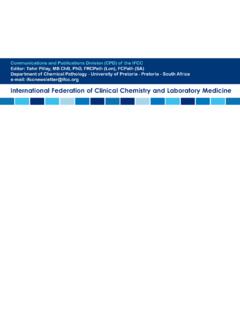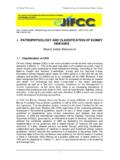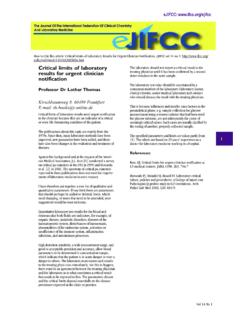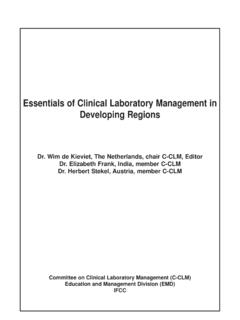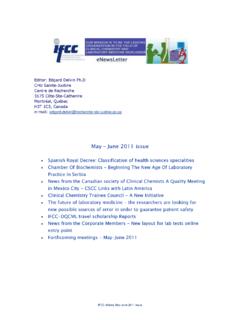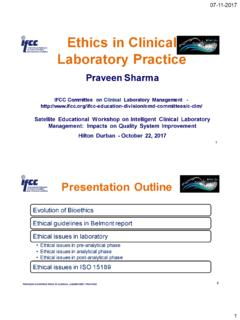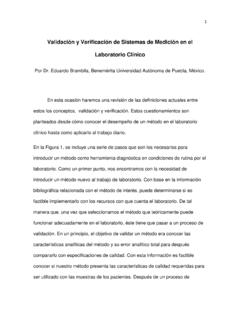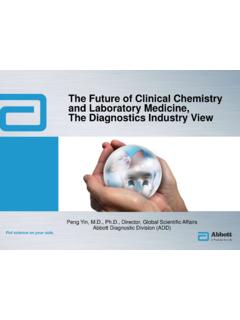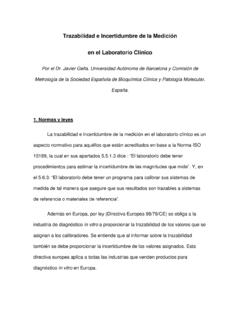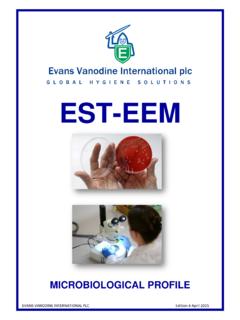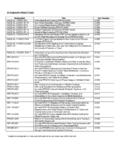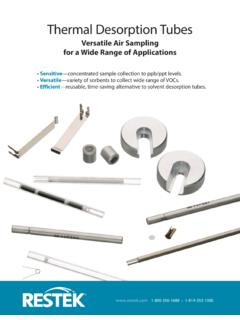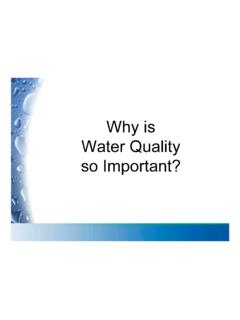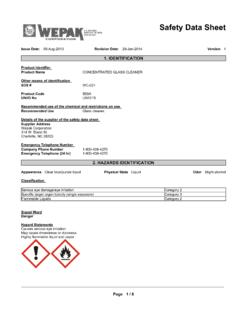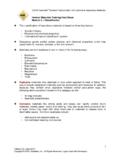Transcription of IFCC international conventional reference …
1 Clin Chem Lab Med 2011;49(8):1275 1281 2011 by Walter de Gruyter Berlin Boston. DOI in press - uncorrected proofIFCC international conventional reference procedure for themeasurement of free thyroxine in serumInternational Federation of Clinical Chemistry and Laboratory Medicine( ifcc ) Working Group for Standardization of Thyroid Function Tests(WG-STFT)1)Sofie K. Van Houcke1, Katleen Van Uytfanghe1,Eri Shimizu2, Wataru Tani2, Masao Umemoto2andLinda M. Thienpont1,*1 Laboratory for Analytical Chemistry, Faculty ofPharmaceutical Sciences, Ghent University, Ghent, Belgium2 Laboratory of reference Material Institute for ClinicalChemistry Standards (ReCCS), Kawasaki, Kanagawa,JapanAbstractThe ifcc Working Group for Standardization of ThyroidFunction Tests proposes a candidate international conven-tional reference procedure (RMP) for measurement of theamount-of-substance concentration of free thyroxine inplasma/serum at physiological pH and temperature( ).
2 The unit for reporting measurement results is, byconvention, pmol/L. The RMP is based on equilibrium dial-ysis isotope dilution-liquid chromatography/tandem massspectrometry (ED-ID-LC/tandem MS). The rationale for pro-posing a conventional RMP is that, because of the physicalseparation step, it is unknown whether the measurement trulyreflects the concentration of free thyroxine (FT4) in , the ED part of the RMP has to strictly adhere tothe following conditions: use of a dialysis buffer with a bio-chemical composition resembling the ionic environment ofserum/plasma as closely as possible; buffering of the sampleto a pH of (at ) before dialysis, however, withoutadditional dilution.
3 Dialysis in a device with a dialysand/dialysate compartment of identical volume and separated bya membrane of regenerated cellulose and adequate cut-off;thermostatic control of the temperature during dialysis " The convention does not apply to the ID-LC/tandem MS part, provided it is eligible to be nominated1)The current membership of the WG-STFT is as follows: L. Thien-pont (BE, Chair); S. Faye (UK); G. Beastall (UK); J. Faix (US);T. Ieiri (JP); R. Janzen (US); G. Miller (US); D. Montague (UK);J. Nelson (US); F. Quinn (US); C.
4 Ronin (FR); Ross (NL);M. Rottmann (DE); J. Thijssen (NL); B. Toussaint (BE).*Corresponding author: Prof. Linda M. Thienpont, Laboratoryfor Analytical Chemistry, Ghent University, Harelbekestraat 72,9000 Ghent, BelgiumPhone:q32-9-264-81-04, Fax:q32-9-264-81-98,E-mail: March 14, 2011; accepted March 28, 2011;previously published online June 21, 2011for review by the Joint Committee for Traceability inLaboratory Medicine. Here, we describe the ED procedure,inclusive its validation and transferability, in greater recommend a protocol for successful calibration, meas-urement and monitoring of the accuracy/trueness and preci-sion of the candidate conventional RMP.
5 For details on ourID-LC/tandem MS procedures, we refer to the :equilibrium dialysis; isotope dilution-liquidchromatography-mass spectrometry; pH ; physiologicalconditions; temperature ifcc Working Group for Standardization of ThyroidFunction Tests (WG-STFT) is mandated among others withestablishing metrological traceability of measurement pro-cedures for free thyroxine (FT4) in plasma/serum. Mean-while, the rationale for this mandate has been documentedin a report on FT4 concentrations measured in a panel ofsera by several immunoassays and routinely applied massspectrometric methods (1).
6 The most discrepant results dif-fered by 40%. In 2007 the WG proposed to define the mea-surand, which is the quantity intended to be measured byFT4 measurement procedures, Plasma/Serum Thyroxine(free); substance concentration (2). According to thisIUPAC/ ifcc format, the component is thyroxine that is notbound to proteins , the kind-of-quantity to measure the amount-of-substance concentration and the system plas-ma or serum at physiological conditions (pH , temper-ature ) . The preferred unit for expression ofmeasurement results is pmol/L.
7 The WG proposed to estab-lish metrological traceability of serum FT4 measurements toa candidate international conventional reference measure-ment procedure (RMP) based on equilibrium dialysis (ED)combined with determination of the T4 concentration of thedialysate with a trueness-based isotope dilution-liquid chro-matography/tandem mass spectrometry (ID-LC/tandem MS)RMP (3). The ED part of the RMP is intended to generatea protein-depleted measurement system by physical separa-tion of protein-bound and FT4. The reasons to select ED andnot ultrafiltration are explained in (3).
8 The rationale for pro-posing a conventional RMP was that, because of thephysical separation step, even if performed under theoreti-cally optimal conditions to respect the free-bound equilibri-1276 Van Houcke et al.: Free thyroxine conventional reference procedureArticle in press - uncorrected proofum, it is unknown whether the T4 measured in the dialysatetruly reflects the FT4 concentration in serum (3, 4). There-fore, the WG preferred to adopt the convention that EDshould be performed with strict adherence to a predefinedprocedure. This implies that the measurand is operationallydefined as thyroxine in the dialysate from ED of serumprepared under defined conditions.
9 The convention doesnot apply to the ID-LC/tandem MS part of the RMP, provid-ed it is calibrated with the certified T4 primary calibratorIRMM 468 listed by the Joint Committee for Traceability inLaboratory Medicine (JCTLM) (5). In addition, it is state-of-the-art to start from a JCTLM listed ID-LC/tandem MSmethod for total T4, but to optimize it towards measurementof picomolar concentrations typical for serum FT4. The WGproposed the ED ID-LC/tandem MS procedure originallydescribed by Van Uytfanghe et al. as preliminary candidateinternational conventional RMP, however, with the require-ment to document its transferability (3, 4).
10 The ED condi-tions were based on the recommendations of the C45-Aconsensus guideline, ,i) the dialysis buffer has a bio-chemical composition that mimics the ionic environment ofthe serum as closely as possible, ii) serum is buffered at (at ), iii) the sample is not diluted before dialysisand the dilution factor does not exceed the inherent 1:2 dilu-tion of dialysis, iv) the temperature during dialysis is keptconstant at within a" interval (as controlledby a calibrated thermometer)(6).Here, we describe the final version of the candidate inter-national conventional RMP for FT4 in serum as implementednow in 2 laboratorieswGhent University and reference Mate-rial Institute for Clinical Chemistry Standards (ReCCS) focus on the methodological aspects which are partof the convention, whereas the variants in the ID-MS designare detailed in the online data supplement.
